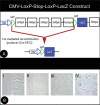Tamoxifen-inducible podocyte-specific iCre recombinase transgenic mouse provides a simple approach for modulation of podocytes in vivo
- PMID: 20641128
- PMCID: PMC3014324
- DOI: 10.1002/dvg.20635
Tamoxifen-inducible podocyte-specific iCre recombinase transgenic mouse provides a simple approach for modulation of podocytes in vivo
Abstract
We report the generation and initial characterization of a mouse line expressing tamoxifen-inducible improved Cre (iCre) recombinase (iCre-ER(T2)) under the regulation of NPHS2 (podocin) gene promoter. The resulting transgenic mouse line was named podocin-iCreER(T2) mice. The efficiency of iCre activity was confirmed by crossing podocin-iCreER(T2) with the ROSA26 reporter mouse. By using the floxed ROSA reporter mice, we found that tamoxifen specifically induced recombination in the kidneys. In the absence of tamoxifen, recombination was undetectable in podocin-iCreER(T2);ROSA26 mice. However, following intraperitoneal injection of tamoxifen, selective recombination was observed in the podocytes of adult animals. We further examined the efficiency of recombination by assessing various tamoxifen exposure regimens in adult mice. These results suggest that podocin-iCre-ER(T2) mouse provides an excellent genetic tool to examine the function of candidate genes in podocytes in a spatially and temporally-restricted manner.
(c) 2010 Wiley-Liss, Inc.
Figures





Similar articles
-
Podocyte-specific expression of tamoxifen-inducible Cre recombinase in mice.Nephrol Dial Transplant. 2010 Jul;25(7):2120-4. doi: 10.1093/ndt/gfq029. Epub 2010 Feb 11. Nephrol Dial Transplant. 2010. PMID: 20150167
-
Construction of a viral T2A-peptide based knock-in mouse model for enhanced Cre recombinase activity and fluorescent labeling of podocytes.Kidney Int. 2017 Jun;91(6):1510-1517. doi: 10.1016/j.kint.2016.12.011. Epub 2017 Feb 7. Kidney Int. 2017. PMID: 28187984
-
A mouse model with tamoxifen-inducible thyrocyte-specific cre recombinase activity.Genesis. 2014 Apr;52(4):333-40. doi: 10.1002/dvg.22740. Epub 2014 Jan 15. Genesis. 2014. PMID: 24395757
-
A tamoxifen-inducible chimeric Cre recombinase specifically effective in the fetal and adult mouse liver.Hepatology. 2002 May;35(5):1072-81. doi: 10.1053/jhep.2002.33164. Hepatology. 2002. PMID: 11981757
-
The a"MAZE"ing world of lung-specific transgenic mice.Am J Respir Cell Mol Biol. 2012 Mar;46(3):269-82. doi: 10.1165/rcmb.2011-0372PS. Epub 2011 Dec 28. Am J Respir Cell Mol Biol. 2012. PMID: 22180870 Free PMC article. Review.
Cited by
-
Inhibition of insulin/IGF-1 receptor signaling protects from mitochondria-mediated kidney failure.EMBO Mol Med. 2015 Mar;7(3):275-87. doi: 10.15252/emmm.201404916. EMBO Mol Med. 2015. PMID: 25643582 Free PMC article.
-
Kidney-specific transposon-mediated gene transfer in vivo.Sci Rep. 2017 Mar 20;7:44904. doi: 10.1038/srep44904. Sci Rep. 2017. PMID: 28317878 Free PMC article.
-
Podocyte cell-specific Npr1 is required for blood pressure and renal homeostasis in male and female mice: role of sex-specific differences.Physiol Genomics. 2024 Oct 1;56(10):672-690. doi: 10.1152/physiolgenomics.00137.2023. Epub 2024 Aug 5. Physiol Genomics. 2024. PMID: 39101921 Free PMC article.
-
Nephrin is necessary for podocyte recovery following injury in an adult mature glomerulus.PLoS One. 2018 Jun 20;13(6):e0198013. doi: 10.1371/journal.pone.0198013. eCollection 2018. PLoS One. 2018. PMID: 29924795 Free PMC article.
-
Identification of microRNA-93 as a novel regulator of vascular endothelial growth factor in hyperglycemic conditions.J Biol Chem. 2010 Jul 23;285(30):23457-65. doi: 10.1074/jbc.M110.136168. Epub 2010 May 25. J Biol Chem. 2010. PMID: 20501654 Free PMC article.
References
-
- Bugeon L, Danou A, Carpentier D, Langridge P, Syed N, Dallman MJ. Inducible gene silencing in podocytes: A new tool for studying glomerular function. J Am Soc Nephrol. 2003;14:786–791. - PubMed
-
- Danielian P, White R, Hoare S, Fawell S, Parker M. Identification of residues in the estrogen receptor that confer differential sensitivity to estrogen and hydroxytamoxifen. Mol Endocrinol. 1993;7:232–240. - PubMed
Publication types
MeSH terms
Substances
Grants and funding
LinkOut - more resources
Full Text Sources
Other Literature Sources
Molecular Biology Databases

